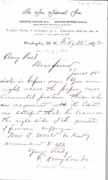BACK TO the African American history
of Western New York
Amy Kirby was born in Jericho, New York on
December 20, 1802. Her parents, Joseph Kirby and Mary Seaman Kirby,
were farmers and she was one of eight children. The Kirby family
belonged to the Society of Friends (Quakers).
When Amy Kirby was in her early 20s, she moved
to Scipio, New York to live with her sister, Hannah Kirby Post,
and brother-in-law, Isaac Post. Hannah died in 1827, and Amy Kirby
married Isaac Post in 1828. In addition to the two children Isaac
Post had with his previous wife Hannah, Isaac and Amy (Post) has
four children of their own: Jacob, Joseph, Matilda, and Willet.
Only four of the children live to be adults (Mary - the
daughter of Isaac and Hannah, Jacob, Joseph, and Willet).
In 1836, the Posts moved from Scipio to Rochester,
New York, to a house at 36 Sophia Street (now North Plymouth Avenue).
That same year, Post's younger sister Sarah also moved to Rochester.
A few years later, in 1839, Isaac Post started a drugstore
-- named Post, Coleman and Willis -- in the Smith Arcade, at 4
Exchange Street in Rochester.
Amy Post became active in the anti-slavery
movement in Rochester soon after she arrived in the city. She
signed a petition against slavery in 1837, and her home, a busy
station on the Underground Railroad, sometimes housed between
ten and twenty fugitive slaves per night. A host of anti-slavery
lecturers also stayed with her when they came to Rochester to
speak. These guests included William Lloyd Garrison, William C.
Nell, Abby Kelley, and Frederick Douglass.
Post helped to found the Western New York Anti-Slavery
Society (WNYASS) in 1842, and throughout the 1840s was active
in organizing and holding a series of anti-slavery fairs in order
to raise money and sympathy for the cause. In 1844, she was selected
to be the WNYASS delegate to the annual meeting of the American
Anti-Slavery Society in New York City and in 1852, when the Society
held its annual meeting in Rochester, she served on the business
committee. In 1853, with Lucy Coleman, she attended a Western
Anti-Slavery Society meeting and went to Canada to visit fugitive
slave communities.
In 1845, Post stopped attending the Rochester
Monthly Meeting of the Society of Friends and left Genesee Yearly
Meeting (Quakers). She left the Quakers because she disagreed
that the Society's ministers and elders had the right to judge
the actions that individual members took in matters of conscience,
such as abolitionism, the belief that there should be no slavery.
(Although Quakers thought slavery was sinful, many ministers and
elders disapproved of the methods used by radical anti-slavery
reformers and looked in disfavor upon their own members who agreed
with these methods.)
|
correspondence with
Frederick Douglass
click to enlargen
 |
Because of her work in the anti-slavery movement,
Post developed friendships and shared correspondence with many
famous anti-slavery advocates. One such friendship was with Harriet
Jacobs, an escaped slave. Jacobs stayed with the Posts for almost
a year while she was in Rochester, and Post encouraged her to
write her autobiography. Jacobs published Incidents in the
Life of a Slave Girl in 1861. Lydia Maria Child wrote its
introduction, and Post, under an assumed named (alias or pseudonym),
wrote the postscript.
During the Civil War, Post tapped into her
vast regional anti-slavery network in order to collect goods
including food, clothing and medical supplies for the newly freed
slaves. She ensured that these were distributed by working with
the agent for the Rochester Ladies' Anti-Slavery Society (LASS)
in Virginia.
In 1884 she published The
Underground Railroad in Rochester
|
references: [Winning
the Vote],


